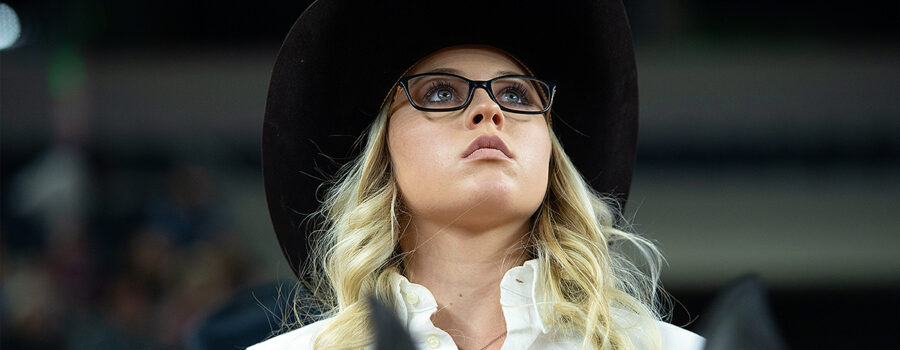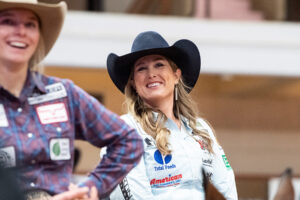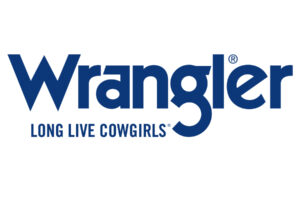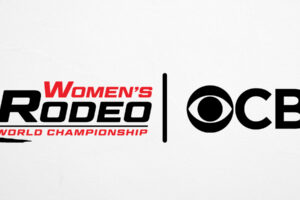For one glorious week in November 2020, the women of professional rodeo took center stage.
Dubbed the richest week in women’s rodeo history, the week was anchored by the first Women’s Rodeo World Championship (WRWC), produced by the World Champions Rodeo Alliance (WCRA) and the Professional Bull Riders (PBR). The inaugural event paid out $750,000 to ladies competing in barrel racing, team roping and breakaway roping.
The event culminated in a three day stretch of Championship Rounds held in conjunction with the PBR World Finals inside AT&T Stadium in Arlington, Texas. In less than 15 minutes of competition time, twenty-four ladies vied for the final big payoff and first ever Women’s Rodeo World titles. The Champions were also featured in the CBS Sports broadcast of the PBR World Finals – exposing Women’s Rodeo to a whole new audience on television.
The field for the finals was much as expected—names like Kelsie Chace, Jackie Crawford, Beverly Robbins, Ivy Saebens and Madison Outhier were all there on the day sheet. But sprinkled amongst the biggest names in the sport were some cowgirls decidedly less well known, at least prior to those moments.
How did these cowgirls rise to prominence in the most lucrative, pressure packed, and loaded competition filled with Hall of Famers and legends?
The genesis of all their individual journeys is found with the introduction of the WRWC’s Challenger Classification. Launched in August 2020 at the Northern Breakaway and Team Roping Championships, Athlete Classification employs ranking systems to place contestants into pools of competition against others of similar experience and skill level.
The experiment was fully tested during the WRWC, which featured qualifying rounds beginning either with Pro or Challenger pools. Both groups advanced through the early rounds separately before finally being grouped together just prior to the Main Event, which determined the six contestants who competed in the Championship Rounds.
For high school senior Paisley Pierce, the Challenger competition was just the incentive she needed to take the chance on entering the WRWC.

“It just had a lot to do with confidence,” admitted Pierce, a cowgirl who followed her family into the sport and who hails from Van Vleck, Texas south of Houston. “I’m not on the same level as J.J. [Hampton, the 18-time Women’s Pro Rodeo Association (WPRA) World Champion] and those girls.”
“Knowing I could enter the Challenger pool was less intimidating and made entering a lot less stressful,” she continued. “Of course, all the girls are talented, no matter which pool.”
Challenger status is established under the Rodeo Logistics Athlete Classifications (RLAC) system using Equi-Stat earnings in Barrel Racing, Global Handicaps Systems numbers in Team Roping and verifiable earnings in Breakaway Roping.
Noting she only recently began to really focus on the breakaway over the “passion of her heart,” barrel racing, Pierce has been focused on high school rodeo—and multiple events including also team roping and pole bending—so she qualified into the Challenger competition.
At the WRWC, Pierce jumped out and won the first round in the Challenger pool with a run of 2.19 seconds, automatically advancing to the next round in the tournament style competition. She later threw down multiple runs in the short two-second range to advance to the Championship Round.
“The nerves were definitely there at AT&T but once I got on my horse, I’m pretty good at blocking everything out that’s going on around me and focusing on what I need to do which is just go rope,” said Pierce.
Roping against nearly 150 entries across all divisions, Pierce finished sixth in the event. In total, she walked away with more than $6,000 in her pockets.
“It was such a great opportunity,” Pierce noted. “It gave me confidence, roping in those early rounds, to go rope against the other girls at the end.”
Pierce was not the lone Challenger athlete to go all the way to the Championships. In the Barrel Racing, another Texas High School Rodeo competitor followed a similar path. Jada Trosper decided to enter the event, which was closer to her home in north Texas, for the experience and took advantage of the Challenger status.
“On our first run, we hit the first barrel we’ve ever hit together,” Trosper said of competing in the preliminary rounds at Will Rogers Memorial Center in Fort Worth. Like Pierce, she noted the confidence building that is proving one of the key perks of the Challenger. “But what opened my eyes was the time we ran—we would have been second in the round so that was a big confidence booster.”

Taking advantage of the second round chance to advance from the qualifiers, Trosper and her great gelding Sun N Sevens, aka Sev, bounced back in the next round to march through the increasingly tough rounds.
“By the time we got to the 24 round, I was just so grateful,” Trosper said. “We really weren’t expecting anything, we entered more for the experience.”
Trosper finished fourth in the Championship Round, earning more than $10,000.
Team Roping has long embraced the tiering concept embodied in their Global Handicap Systems. At the time, to be eligible for Challenger competition, the team’s combined number must be #9.5 or lower with individual team members capped at #5.
As a Team Roper, during the same weekend as the WRWC, Hope Thompson clinched her second WPRA World Championship as a header in Waco at the WPRA World Finals, roping with heeling phenom Whitney DeSalvo. Thompson and DeSalvo qualified in the open portion of the WRWC as a #13.5 team.
Despite the many accolades, Thompson was able to compete in the Challenger at the WRWC as a heeler, roping behind Rylie Smith, the 2020 WPRA Rookie of the Year in Heeling.
“Rylie and I were able to enter the Challenger because we switched ends. We were an #8.5 team that way,” said Thompson who is a #5.5 as a header and #4.5 as a heeler. “We actually entered that way trying to gain all-around points!”
The talented duo roped their way through the Challenger pool rounds in Fort Worth, despite roping in opposite roles from that which they are accustomed. Like the teenagers in the Barrels and Breakaway, Smith and Thompson advanced out of the Challenger pool and kept on winning as the competition grew fiercer deeper into the event.
Once in the Championship Round, the duo displayed steady nerves, the only team to catch in front of the crowd of tens of thousands of fans. They made their mark in history as the first ever Women’s Rodeo World Champion Team Ropers and, thanks to ground money, won the largest paycheck ever presented in women’s rodeo for a single night, an eye-popping $90,000 each.

“We hadn’t entered switched ends or entered that way until that week,” Thompson noted.
Since its inception in May 2018, the World Champion’s Rodeo Alliance has poured millions of dollars into professional rodeo, evolving formats to continually seek to reach its stated goal of expanding opportunities for all rodeo athletes, both the 20% considered professionals who win 80% of the offered prize money but also the rest—the semi-retired, the up-and-coming, the inexperienced and the part-time cowboys and cowgirls who comprise the backbone of the sport.
Following the undeniable success of the new Challenger competition, as well as the Women’s Rodeo World Championship itself, the WCRA continues to innovate in 2021. Alongside the PBR, the WCRA has already announced that the second annual Women’s Rodeo World Championship will take place in early November in Las Vegas in conjunction with the PBR World Finals.
Unlike the inaugural event, however, both Open/Pro and Challenger athletes will be able to nominate events towards a Leaderboard for the event. The dual Leaderboards more fully realize the goal of leveling the playing field that the Challenger was designed to do. Top contenders from the leaderboards receive certain added perks, including advancement past early qualifying rounds and paid entry fees.
Pierce is already ranked 12th on the Open/Pro Leaderboard as she looks forward to the 2021 WRWC as well as recently announced Rodeo Corpus Christi which is nearly in her backyard.
“It’s an exciting opportunity for Breakaway ropers,” noted Pierce, who plans to compete in college rodeo in the future. “I’m so happy to get to be a part of this.”
She notes that competing through the Challenger competition has rocketed her down this path, with goals that now appear much closer than prior to the WRWC.
“The Challenger opens so many doors to give us the confidence to rope against Lari Dee [Guy], Hope and Jackie [Crawford, the WRWC All Around Champ],” she said. “That’s where I needed to be at that time to set myself up to realize that I can rope with these girls.”
“It was such a surreal feeling,” concluded Pierce, whose Region VII Texas High School Rodeo fellow competitor and friend Madison Outhier won the Women’s Rodeo World title. “It was such a prestigious event . . . I wish everyone could do it because it was just an awesome experience.”
Thanks to the addition of the Challenger competition, many more female rodeo athletes can realistically find themselves immersed in that feeling as well in the future.
The 2021 Women’s Rodeo World Championship is scheduled for the week of November 3-7, 2021 at the South Point Equestrian Center and T-Mobile Arena in Las Vegas and will again feature a $750,000 payout.
Rodeo Corpus Christi will contest under the banner of the WCRA for the first time in 2021 and will kick off with qualifying rounds May 3-8 and the WCRA Major Performance on May 9 with the Showdown Round and Triple Crown of Rodeo Round. Rodeo Corpus Christi will award over $500,000 in prize money across ten rodeo disciplines.
For more information visit wcrarodeo.com. Athletes can nominate events toward either the Pro and Challenger Leaderboards using the WCRA’s innovative Virtual Rodeo Qualifier (VRQ).





